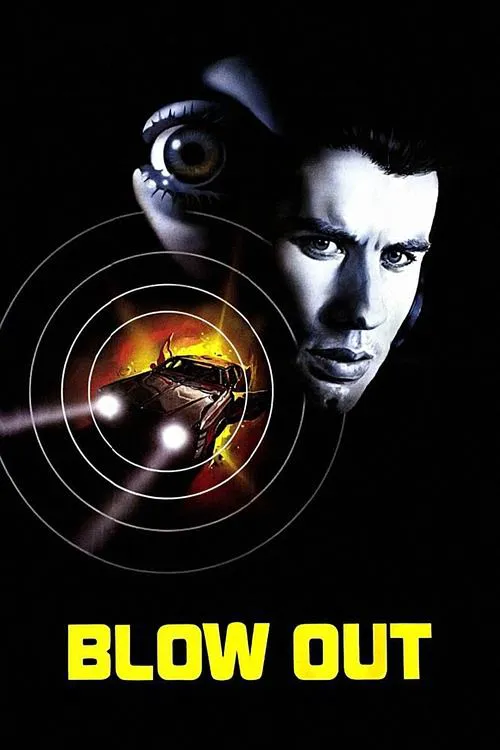Blow Out

Plot
Brian De Palma's 1981 psychological thriller, Blow Out, expertly weaves together a complex narrative that delves into the realms of murder, politics, identity, and the blurred lines between reality and fiction. The movie takes inspiration from De Palma's own experiences while working on another film in 1974, when a car drove off a bridge in Rome, Italy. Although the actual car crash did not result in the loss of life, the event sparked the idea for Blow Out, a film that deconstructs and reassembles the conventions of Hollywood cinema. We are introduced to Jack Terry, a resourceful and ambitious sound effects specialist working under the umbrella of a low-budget film production company in 1980s Philadelphia. His job is to capture realistic sound effects for various scenes, often using unconventional methods that involve placing his microphone in the midst of chaos. Jack is an ambitious worker, always chasing the next big opportunity and willing to take risks to get ahead. One fateful night, while working on a horror film, Jack stumbles upon a real-life horror. A car careens off a concrete bridge and into the Schuylkill River, sending debris and bodies flying. Without hesitation, Jack jumps into the water and rescues a mysterious woman named Sally, while the other passenger in the car is killed. To their surprise, they discover that the deceased is John Pappas, the newly appointed Governor of Pennsylvania, who had been planning to announce his candidacy for the presidential election. As Jack begins to review the footage captured on his tapes, he becomes increasingly entangled in the intricate web of conspiracy surrounding Governor Pappas's death. Sensing an opportunity to get ahead in his career, Jack decides to investigate further and starts a complicated romance with Sally, whose fragile identity is shrouded in mystery. Sally is hiding a dark past, having witnessed her parents' death at the hands of her abusive father, and her experiences in an orphanage have left her with deep emotional scars. As Jack digs deeper into the truth behind the Governor's death, he finds himself trapped in a nightmare of deceit and power struggles. Pappas was involved in a string of illicit activities, including corruption and blackmail, which could potentially derail his presidential ambitions. Jack soon discovers that a team of ruthless individuals is willing to silence anyone who gets too close to the truth. De Palma crafts a thrilling narrative where reality blurs with the artifice of filmmaking. Jack's investigation leads him into a world of film noir aesthetics, where the lines between truth and fiction are continually crossed. Jack is no stranger to the constructed reality of cinema, and his work in film often allows him to navigate the blurred lines between these two worlds. However, his pursuit of the truth leads him into a treacherous web of conspiracy that threatens to consume him whole. The movie is an homage to Alfred Hitchcock's mastery of suspense and the art of filmmaking. De Palma's Blow Out features a rich visual style, which draws inspiration from classic horror films. The tension builds up gradually, with a slow-burning narrative that takes us on a journey deep into the heart of Jack's world. De Palma masterfully manipulates the viewer's perceptions, playing with their expectations and blurring the lines between reality and fiction. Throughout the film, Jack's character serves as a reflection of De Palma's own anxieties and fears as a filmmaker. Jack's obsession with capturing the truth, his constant need to verify reality, and his struggles with the ethics of filmmaking make him a deeply sympathetic character. As the story unfolds, Jack becomes increasingly entangled in the web of conspiracy, struggling to discern fact from fiction. The final act is a masterclass in tension and suspense, with De Palma's expert direction manipulating the viewer's emotions and creating a sense of unease that permeates every scene. The tragic conclusion of the film serves as a scathing critique of the corrupt systems of power that allow such atrocities to occur in the shadows. Ultimately, Blow Out is a gripping, unsettling thrill ride that challenges the viewer to question the very fabric of reality. De Palma's masterpiece is a commentary on the corrupt systems of power, the artifice of filmmaking, and the complexities of identity, while also paying homage to the classic films of Alfred Hitchcock.
Reviews
Amara
The opening slasher/giallo homage is stunning. The intricate setup of the "mystery" seems ingenious at first, but the interesting details are abandoned during the reconstruction of the event. The ultimate resolution can only be explained as "the director grasping for an excuse to end the film." Compared to its inspiration, "Blow Up," the two films share an identical structure; however, one ascends while the other descends.
Frances
De Palma's most brilliant and self-reflexive work. Building upon Blow-Up's exploration of the visual and The Conversation's focus on the audio, Blow Out cleverly delves into the synchronization of sound and image. By centering on sound, it seamlessly weaves a post-Kennedy assassination political conspiracy into the film's post-production process, creating a stunning meta-cinematic loop.
Recommendations




